
Green Witch
Book Description
Magic brews in the heart of a small town as secrets intertwine with desires in "Green Witch" by Alice Hoffman. A young woman discovers her extraordinary gift for connecting with nature and healing, but her emerging powers draw the attention of those who would exploit them. Complicated friendships blossom and dark family legacies threaten to unravel everything she holds dear. The balance between love and betrayal hangs in the air, charged with expectation and fear. As whispers of danger grow louder, can she embrace her true self before it’s too late? What happens when the line between magic and reality begins to blur?
Quick Book Summary
"Green Witch" by Alice Hoffman tells the story of Green, a young woman living in a post-catastrophe world where magic intertwines with reality. Following the devastation that destroyed her town and family, Green retreats inward, relying on her connection with plants and the earth to find solace and meaning. As she discovers her abilities to heal and commune with nature, Green is faced with a community distrustful of difference and a world shaped by loss. Through encounters with other outsiders and the lingering threat of those seeking to manipulate her gifts, Green must find the courage to embrace her identity, mend her shattered heart, and determine how her powers can help rebuild what was lost. Her journey is one of self-discovery, resilience, and hope.
Summary of Key Ideas
Table of Contents
Nature and Healing as Transformation
Green’s world is shattered after the “Destruction,” an event that leaves her town in ruins and her family gone. Grief-stricken, she isolates herself, allowing physical scars to mirror her emotional pain. She tends to her garden, finding comfort in growing herbs and flowers. As Green tends to the natural world, she senses her growing connection to its rhythms, discovering she can intuit the needs of plants and harness their healing properties. This relationship with nature becomes both a refuge and the seed of her magical abilities.
Isolation and Community
As time passes, Green encounters other survivors who also bear their own burdens. Through cautious friendships with these outsiders—such as the mysterious painter, the silent boy, and an old healer—Green slowly rebuilds her trust in people. Their shared experiences foster a fragile sense of community, challenging her to step beyond her grief. The bonds formed illustrate how healing often requires both solitude and connection, and that even the most isolated can find belonging through understanding and support.
The Legacy of Family and Past Trauma
The memory of Green’s family and the persistent weight of loss linger, influencing her every decision. She uncovers hidden truths about her lineage, revealing a legacy intertwined with both hope and sorrow. The narrative explores how old wounds and family histories shape the present, while also presenting the possibility of overcoming inherited pain. Green’s journey illustrates the struggle to accept and confront the past, ultimately teaching her that forgiveness and remembrance are essential parts of moving forward.
The Conflict between Magic and Exploitation
As Green’s powers attract attention, she becomes vulnerable to manipulation by those who seek to capitalize on her abilities. The story raises questions about the ethical use of magic, the dangers of power, and the threat posed by those who fear or misunderstand the magical. Green must navigate challenges that test her judgment and resolve, learning when to protect herself and when to trust. The tension between embracing her gifts and guarding against exploitation forms a central conflict, reflecting broader themes of fear, control, and acceptance.
Self-Acceptance and Empowerment
Throughout her journey, Green grapples with her own self-worth and identity. As she learns to harness her abilities responsibly, she ultimately embraces her true self—both her pain and her promise. Her transformation is marked by resilience: accepting her scars, opening herself to love and friendship, and daring to hope even in the aftermath of destruction. The novel closes with Green forging a new path, empowered by the very gifts and experiences that once made her feel different and alone, symbolizing the healing power of self-acceptance and courage.
Download This Summary
Get a free PDF of this summary instantly — no email required.





